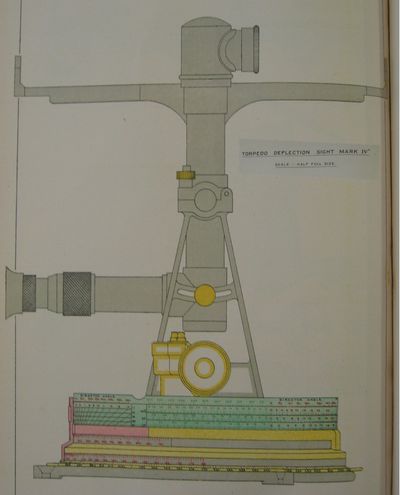Torpedo Deflection Sight Mark IV

Notice open sights alongside, which would not afford the user the blast protection.
The Torpedo Deflection Sight Mark IV Types were actually a family of British torpedo deflection sights created for use from armoured sighting positions in capital ships armed with 21-inch torpedoes.[4]
Design
Initially designed with a sighting telescope sitting atop the mechanism, these would be sited in port/starboard pairs in armoured control positions, peeking out the slot in the armour.
These were made in port and starboard "handed" models owing to the various angles of tube inclination between ships and these angles being reversed on the two broadsides. A suffix of "a" was used for starboard, and "b" for port.
- Mark IVa and IVb were for ships with tubes at 90 degrees (Hood, Repulse, Courageous, Royal Sovereign, Colossus and Lion classes, and Furious and Orion)
- IV*a and IV*b for ships with forward tubes at 80 degs and aft at 100 degs: Queen Elizabeth and Iron Duke classes
- IV**a and IV**b for ships with tubes at 80 degs: King George V class and Orion class except Orion
- IVa (special) and IVb (special) for ships with tubes at other assorted inclinations: Tiger, Canada, Agincourt, and Erin
The differences between the sights was limited to the gyro angle scale and the reader.
Allocation
The first four, with telescopes, were delivered in February 1917 and issued to Warspite for trial. The results were highly satisfactory and justified the decision to adopt them for heavy gun ships.[5]
These sights were to be provided two per ship by C.I.O 3977 of 1917, and by the end of 1918, all ships had been so fitted.
By mid 1919, Royal Sovereign, Benbow, Iron Duke Lion Emperor of India Marlborough, Ramillies and Queen Elizabeth were completely equipped and Renown had two. Other existing T.D.S. Mark IVs were to be adapted for the periscope at the next refit.[6]
Alterations
Following the trial in Warspite, concerns of blast and a desire to drive the Torpedo Control Evershed (see ARTS 1917 page 208) from the sight prompted interest in moving from the telescope to periscope binoculars.[7]
Unfortunately, the proposal to add binocular periscopes to better shield the user from gun blast was found unworkable for the added weight (50 pounds!) and a lighter design did not seem easily achievable given other commitments. As a result, a monocular periscope of field 13 degrees and power 3 was chosen that could be elevated or depressed 12.5 degrees. The periscope was to be kept in its storage box when not in use. A set of coloured shades for the eyepiece were provided.
The periscope proved satisfactory to the degree that it was proposed that the Evershed torpedo control transmitter should be placed here rather than on the torpedo rangefinder. [8]
Loose Gyro Bearing Ring

To assist in divisional torpedo control, a ring was added so a gyro compass bearing from 0 to 360 degrees could quickly be converted to a gyro angle. Some sights (IV, IV**, and IV Special for Agincourt and Erin) could be adapted by merely adding pointers to the deflection readers, whereas others needed a completely new reader (IV* and IV Special for Canada and Tiger). These would be added by Portsmouth Yard when sights were updated to the periscope, but the staff of the ships listed above would adapt their fully updated sights themselves.[10]
The rings would be used as follows.[11]
When told to fire a torpedo on a given gyro bearing, the user would
- turn the loose ring to the bearing of ship's head, placing it at zero degrees on the bearing scale on the after side of the instrument.
- turn the reader by using the deflection working head until the new extension pointer is over the given gyro bearing
- the tube arrows would then indicate the necessary gyro angle
When told to fire a torpedo at a target on a given gyro bearing, the user would
- turn the loose ring to the bearing of ship's head, placing it at zero degrees on the bearing scale on the after side of the instrument.
- Set deflection to zero
- turn the sight by using the training head until the pointer is over the given gyro bearing
- apply the desired deflection
- the tube arrows would then indicate the necessary gyro angle
See Also
Footnotes
- ↑ Annual Report of the Torpedo School, 1918, Plate 110.
- ↑ Annual Report of the Torpedo School, 1918, Plate 112.
- ↑ Annual Report of the Torpedo School, 1918, Plate 113.
- ↑ Annual Report of the Torpedo School, 1917, p. 190. (C.M.O. 3977 of 1917, G. 14352/17)
- ↑ Annual Report of the Torpedo School, 1917, p. 190.
- ↑ Annual Report of the Torpedo School, 1918, pp. 157-158.
- ↑ Annual Report of the Torpedo School, 1917, p. 190.
- ↑ Annual Report of the Torpedo School, 1918, pp. 157-158.
- ↑ Annual Report of the Torpedo School, 1918, Plate 111.
- ↑ Annual Report of the Torpedo School, 1918, p. 158
- ↑ Annual Report of the Torpedo School, 1918, pp. 158-159.
Bibliography

